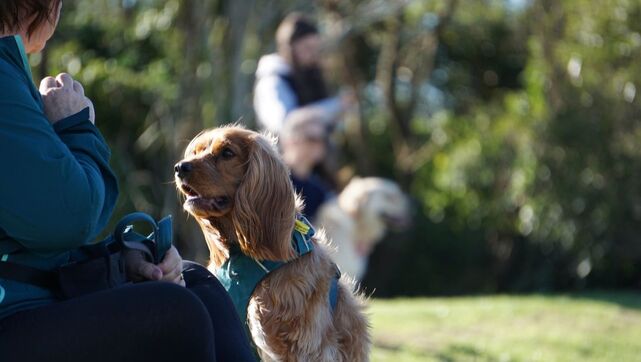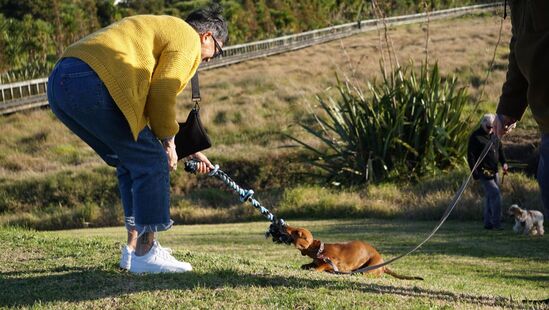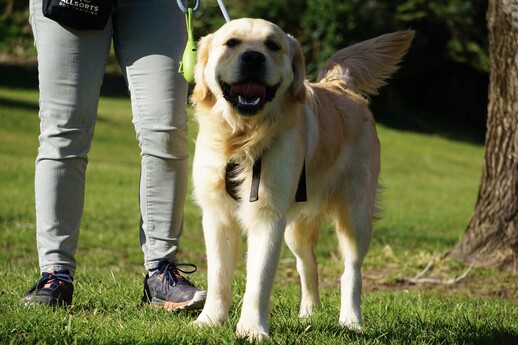|
Upon welcoming a new furry friend to the family, many of us have big plans. Our goals in having a well trained dog have our pooch put through a rigorous/intensive training schedule. Although we mean well and have the best intentions in investing this sort of time into our newest family members, sometimes this approach won’t get you any further along than another dog with a non-existent training schedule. With this in mind, here are some do’s and don'ts of training - some Dog Training 101, if you will. Keep It Short and Sweet Young dogs, just like children, aren’t capable of long periods of focus. Starting with short training sessions of 5-10 mins or less, up to 4 times a day are best (once or twice a day is also fabulous, something is always better than nothing). Make it Worth Their While Training can be laborious for young dogs, and it's not necessarily something they would choose to do. Add in short spurts of play time throughout your training. This can build value for the training itself, but also teaches your dog that the boring stuff isn’t forever, and you will give them a good outlet often. Always pay up. Remember, training isn’t something a dog thinks it needs, it’s something we put them through. It is mainly for our benefit that we want our dogs to be trained, but that reason is not good enough for them to decide to opt in to the training. We must compensate them for their efforts. Training is work, if you’re asking your dog to work, be prepared to pay up. If you're asking your dog to work around distractions, be prepared to give them a raise. Break it Down As humans, we often place some pretty high expectations on our furry friends, mostly because our human brain is super advanced and we don’t often recognise the complexity in what would normally be deemed a “simple” task. Dogs don’t speak English. You can say sit as many times as you want, it doesn’t change the fact that your dog doesn’t speak English, and it certainly doesn’t come preprogrammed “just knowing” what sit, or any other cue, means. Use food or a toy to lure your dog through the manoeuvres you’re after, or wait for the moment they happen to do the behaviour you like and reward them. With practice, your dog will understand the movement, at which point you should then start to introduce a cue word. On that note, physically manipulating your dog into positions doesn’t teach them much, as they don’t learn how to use those muscles to achieve that position. Be careful here though, again, our human brain will tell us that because the dog did it once, they get it, right? WRONG. In general it takes around 12 repetitions for a dog to build the pattern and learn a new concept. But Wait - There’s More to This! That’s just to learn the concept. It doesn’t make the behaviour reliable by any means. Practice is still required to get a faster response and build habits. BUT I caution you again. Lots of practice at home DOES NOT make a behaviour reliable out and about. If your dog is well practised at something at home, that’s amazing, but I’m sorry to tell you, dogs do not transfer their learning as easily as we do. Practising things at home is good, it's an easy environment for your dog to learn in, and the low distractions allow them to learn effectively. It’s great to begin the training of a new concept at home first. The environment is one they are comfortable in, distractions are low, and learning can be done relatively fast and effectively. If, however, you only practise your sit at home, well you can certainly guarantee that your dog will have a pretty sharp sit… AT HOME. Not necessarily in other places though. In order for a behaviour to become truly reliable, it needs to be practised in a range of environments and contexts. Set Them up for Success This brings me to my next point, its pretty cool when you’ve done some training and you want to see how it holds up in other places. Pick these other places wisely, don’t just go anywhere. Pick a low distraction environment, and go in an off-peak hour. Allow them time to acclimate, then start with the absolute basics and go from there. There is no point in testing your dog and just seeing how they go. You are setting them up to fail, and setting yourself up to get frustrated with them. Be smart. There are two parts to this:
Once you’ve got some good sessions under your belt, and your dog's skill repertoire begins expanding, you may find that both you and them really enjoy the training time. It’s really rewarding for you when you can see that hard work is paying off and your dog is absorbing everything you’re giving them. It's also rewarding for your dog, having all that special one on one time, being challenged mentally and having such frequent successes is a real confidence booster. Over time you may also find that this history of learning can actually accelerate how fast they pick up new concepts in future. Always Finish on a Good Note It's tempting to keep pushing and seeing how much your dog can accomplish, but in doing this adds extra pressure to your dog, can undermine their confidence, and start to take away the enjoyment of learning or even hinder some of that learning, as they don’t have the down time to process. In our experience, dogs do much better with training sessions that are short and sweet, and have finished on a good note, with them still wanting more. So in short, quit while you’re ahead. This was alluded to before, but when you start seeing some good progress with your dog, you both are likely to really start enjoying working together and are likely to catch a training bug! This isn’t a bad bug, it's definitely one to embrace. Relationship is Key With that in mind, there is a hidden aspect about training well that becomes really solid. When you train with compassion, understanding and positivity, you build a relationship where your dog trusts and enjoys the time spent with you. If you train with high expectations, corrections and frustration, your dog is unsure and the ‘training game’ isn’t worth it for them. Make sure you cultivate a safe space to learn, try new things, and you will really start to see phenomenal progress. Training is for Life If your dog enjoys the training, if you enjoy the training, then what possible reason could there be for you to stop the training?! There is a misbelief that you can’t teach an old dog new tricks, and it's rubbish! You absolutely can, and absolutely should. As older dogs, physical capabilities may not be what they used to be, so what better activity than a mental workout learning something new. And this isn’t just true for dogs, it’s true for humans too! Keep striving, keep learning, keep training. We will all be better off if we do. Authors
Brooke Rapira Prime Pups Educator and Dog Sport Instructor Sarah Endres Dog Trainer and Behaviour Advisor
0 Comments
Leave a Reply. |
AuthorsArticles created by the team at Allsorts Dog Training, Bay of Plenty, New Zealand Our Library
All
|




 RSS Feed
RSS Feed